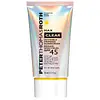What's inside
What's inside
 Key Ingredients
Key Ingredients

 Benefits
Benefits

 Concerns
Concerns

 Ingredients Side-by-side
Ingredients Side-by-side

Butyl Methoxydibenzoylmethane 3%
UV AbsorberHomosalate 15%
Skin ConditioningEthylhexyl Salicylate 5%
UV AbsorberOctocrylene 10%
UV AbsorberCoco-Caprylate/Caprate
EmollientDimethicone
EmollientTriheptanoin
Skin ConditioningSilica
AbrasiveButyloctyl Salicylate
Skin ConditioningC9-12 Alkane
SolventDilinoleic Acid/Butanediol Copolymer
Silica Silylate
EmollientTribehenin
EmollientSorbitol/Sebacic Acid Copolymer Behenate
Skin ConditioningC26-28 Alkyl Dimethicone
Skin ConditioningDimethicone/Vinyl Dimethicone Crosspolymer
Skin ConditioningPolyphenylsilsesquioxane
Dimethicone Crosspolymer
Emulsion StabilisingCellulose
AbsorbentEthylcellulose
Water
Skin ConditioningCastor Oil/Ipdi Copolymer
Tocopheryl Acetate
AntioxidantBisabolol
MaskingButyl Methoxydibenzoylmethane 3%, Homosalate 15%, Ethylhexyl Salicylate 5%, Octocrylene 10%, Coco-Caprylate/Caprate, Dimethicone, Triheptanoin, Silica, Butyloctyl Salicylate, C9-12 Alkane, Dilinoleic Acid/Butanediol Copolymer, Silica Silylate, Tribehenin, Sorbitol/Sebacic Acid Copolymer Behenate, C26-28 Alkyl Dimethicone, Dimethicone/Vinyl Dimethicone Crosspolymer, Polyphenylsilsesquioxane, Dimethicone Crosspolymer, Cellulose, Ethylcellulose, Water, Castor Oil/Ipdi Copolymer, Tocopheryl Acetate, Bisabolol
Titanium Dioxide 1.93%
Cosmetic ColorantZinc Oxide 19.24%
Cosmetic ColorantWater
Skin ConditioningButyloctyl Salicylate
Skin ConditioningC9-12 Alkane
SolventCarthamus Tinctorius Oleosomes
EmollientIsodecyl Neopentanoate
EmollientDicaprylyl Carbonate
EmollientCetyl Alcohol
EmollientCoco-Caprylate/Caprate
EmollientPropanediol
SolventEthylhexyl Olivate
Skin ConditioningGlyceryl Stearate
EmollientPEG-100 Stearate
Cetearyl Olivate
Stearyl Phosphate
EmulsifyingTriethoxycaprylylsilane
Phenoxyethanol
PreservativeOleth-3 Phosphate
Sorbitan Olivate
EmulsifyingHdi/Trimethylol Hexyllactone Crosspolymer
Alumina
AbrasiveXanthan Gum
EmulsifyingPolymethylsilsesquioxane
Polyhydroxystearic Acid
EmulsifyingSqualane
EmollientGluconolactone
Skin ConditioningSodium Phytate
Isopropyl Titanium Triisostearate
EmollientSodium Benzoate
MaskingHydrogen Dimethicone
Potassium Sorbate
PreservativeSilica
AbrasiveTocopheryl Acetate
AntioxidantAscorbic Acid
AntioxidantDiamond Powder
AbrasiveIron Oxides
Mica
Cosmetic ColorantTitanium Dioxide 1.93%, Zinc Oxide 19.24%, Water, Butyloctyl Salicylate, C9-12 Alkane, Carthamus Tinctorius Oleosomes, Isodecyl Neopentanoate, Dicaprylyl Carbonate, Cetyl Alcohol, Coco-Caprylate/Caprate, Propanediol, Ethylhexyl Olivate, Glyceryl Stearate, PEG-100 Stearate, Cetearyl Olivate, Stearyl Phosphate, Triethoxycaprylylsilane, Phenoxyethanol, Oleth-3 Phosphate, Sorbitan Olivate, Hdi/Trimethylol Hexyllactone Crosspolymer, Alumina, Xanthan Gum, Polymethylsilsesquioxane, Polyhydroxystearic Acid, Squalane, Gluconolactone, Sodium Phytate, Isopropyl Titanium Triisostearate, Sodium Benzoate, Hydrogen Dimethicone, Potassium Sorbate, Silica, Tocopheryl Acetate, Ascorbic Acid, Diamond Powder, Iron Oxides, Mica
Ingredients Explained
These ingredients are found in both products.
Ingredients higher up in an ingredient list are typically present in a larger amount.
Butyloctyl Salicylate is a chemical UV filter structurally similar to octisalate. It is a photostabilizer, SPF booster, emollient and solvent. This ingredient helps evenly spread out ingredients.
According to a manufacturer, it is suitable for pairing with micro Titanium Dioxide, Zinc Oxide, and pigments.
Photostabilizers help stabilize UV-filters and prevents them from degrading quickly.
Learn more about Butyloctyl SalicylateC9-12 Alkane is synethically created using alkanes, or paraffins. It is added to products as a solvent. This means its main purpose is to help dissolve ingredients and create even texture.
Coco-Caprylate/Caprate is created from fatty coconut alcohol, caprylic acid, and capric acid.
It is a lightweight emollient. Emollients create a thin barrier on the skin to trap moisture in. This helps keep your skin hydrated and soft.
Once applied, Coco-Caprylate/Caprate is absorbed quickly and leaves a silky feel.
Coco-Caprylate/Caprate may not be fungal acne safe.
Learn more about Coco-Caprylate/CaprateSilica, also known as silicon dioxide, is a naturally occurring mineral. It is used as a fine, spherical, and porous powder in cosmetics.
Though it has exfoliant properties, the function of silica varies depending on the product.
The unique structure of silica enhances the spreadability and adds smoothness, making it a great texture enhancer.
It is also used as an active carrier, emulsifier, and mattifier due to its ability to absorb excess oil.
In some products, tiny microneedles called spicules are made from silica or hydrolyzed sponge. When you rub them in, they lightly polish away dead skin layers and enhance the penetration of active ingredients.
Learn more about SilicaTocopheryl Acetate is AKA Vitamin E. It is an antioxidant and protects your skin from free radicals. Free radicals damage the skin by breaking down collagen.
One study found using Tocopheryl Acetate with Vitamin C decreased the number of sunburned cells.
Tocopheryl Acetate is commonly found in both skincare and dietary supplements.
Learn more about Tocopheryl AcetateWater. It's the most common cosmetic ingredient of all. You'll usually see it at the top of ingredient lists, meaning that it makes up the largest part of the product.
So why is it so popular? Water most often acts as a solvent - this means that it helps dissolve other ingredients into the formulation.
You'll also recognize water as that liquid we all need to stay alive. If you see this, drink a glass of water. Stay hydrated!
Learn more about Water